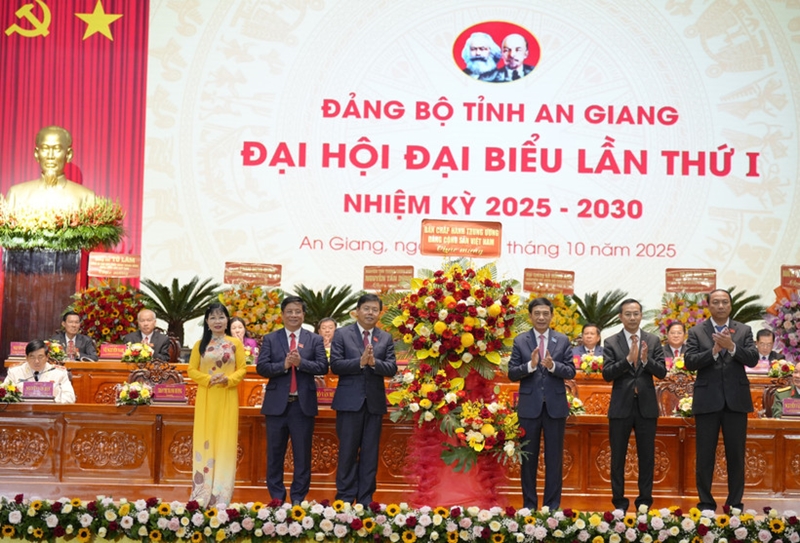General Phan Van Giang, Politburo member, Deputy Secretary of the Central Military Commission, and Minister of National Defense, made the requested while addressing the first Congress of the An Giang provincial Party Organization for the 2025–2030 tenure on October 3.
    |
 |
|
General Phan Van Giang, Politburo member, Deputy Secretary of the Central Military Commission, and Minister of National Defense (third from the right), presents a flower basket on behalf of the Communist Party of Vietnam Central Committee to congratulate the congress. |
At the congress, the Politburo’s decision on the assignment of the provincial Party Committee, the Standing Board, and key leadership positions for the 2025–2030 tenure was announced. Accordingly, the An Giang Party Committee will have 66 members, including 16 in the Standing Board. Nguyen Tien Hai, member of the Party Central Committee and Secretary of the provincial Party Committee for the 2020–2025 term, has been assigned to continue serving as Secretary of the provincial Party Committee.
Giang emphasized the need for An Giang province to build a clean, strong and comprehensive Party organization and political system, streamline its apparatus, and enhance efficiency and effectiveness in governance.
The province was urged to identify three key breakthroughs for the coming years, including developing the maritime economy to become a strong national marine economic hub. It should also promote marine tourism, with Phu Quoc special zone as the focal point, and prioritize the development of urban areas and infrastructure to support the marine economy.
The province must also upgrade and expand infrastructure, foster breakthroughs in science, technology, and digital transformation, with a particular focus on building e-administration, he said.
According to Giang, An Giang needs to accelerate institutional reform, improve competitiveness, create a transparent and favorable investment environment, and attract selective investment. The province should continue to expand cross-border trade, strengthen linkages with major FDI enterprises, and actively integrate into global value chains. With its significant potential and advantages, Giang expressed his belief that An Giang can achieve an economic growth rate of 11% or higher during the new tenure.
He urged the province to strive to become a driving force of the Mekong Delta, with a focus on developing Phu Quoc into a modern, green, clean, and beautiful special zone, worthy of hosting APEC 2027.
Alongside economic development, An Giang will need to ensure harmony between growth and social issues, continuously improving people’s living standards, while implementing the Party’s resolutions on breakthroughs in science, technology, innovation, digital transformation, education, training, and private sector development.
During the 2020–2025 tenure, the province effectively carried out three major tasks: administrative reform; mobilizing and unlocking resources for socio-economic infrastructure development; and building high-quality human resources. It also implemented five key programs on urban development, human resource development, the national target program on new-style rural development, socio-economic development in ethnic minority and mountainous areas, and sustainable poverty reduction.
As a result, the province achieved average GRDP growth of 5.68% per year, expanded its economic scale, and ensured proper economic restructuring. Agriculture is the backbone of the local economy, with improved productivity and competitiveness. Trade, services, and tourism continued to grow, while total export turnover reached 9.29 billion USD, up 9.39% year on year.
The marine economy, accounting for 80% of the provincial GRDP, has developed significantly. Border trade has been consolidated through investment in border gates, logistics, and cross-border commerce, forming a new growth pole linked to defense and security.
Currently, An Giang’s Party organization has 107 subordinate Party organizations, 931 grassroots-level Party organizations, and 131,548 Party members. The province has completed the reorganization of its two-tier administration system, comprising 102 commune-level units. Cultural, educational, healthcare, and social welfare indicators have improved, with the poverty rate reduced to 0.91%. National defense and security have been firmly safeguarded, while external relations, especially with Cambodia, have been further expanded.
Source: VNA